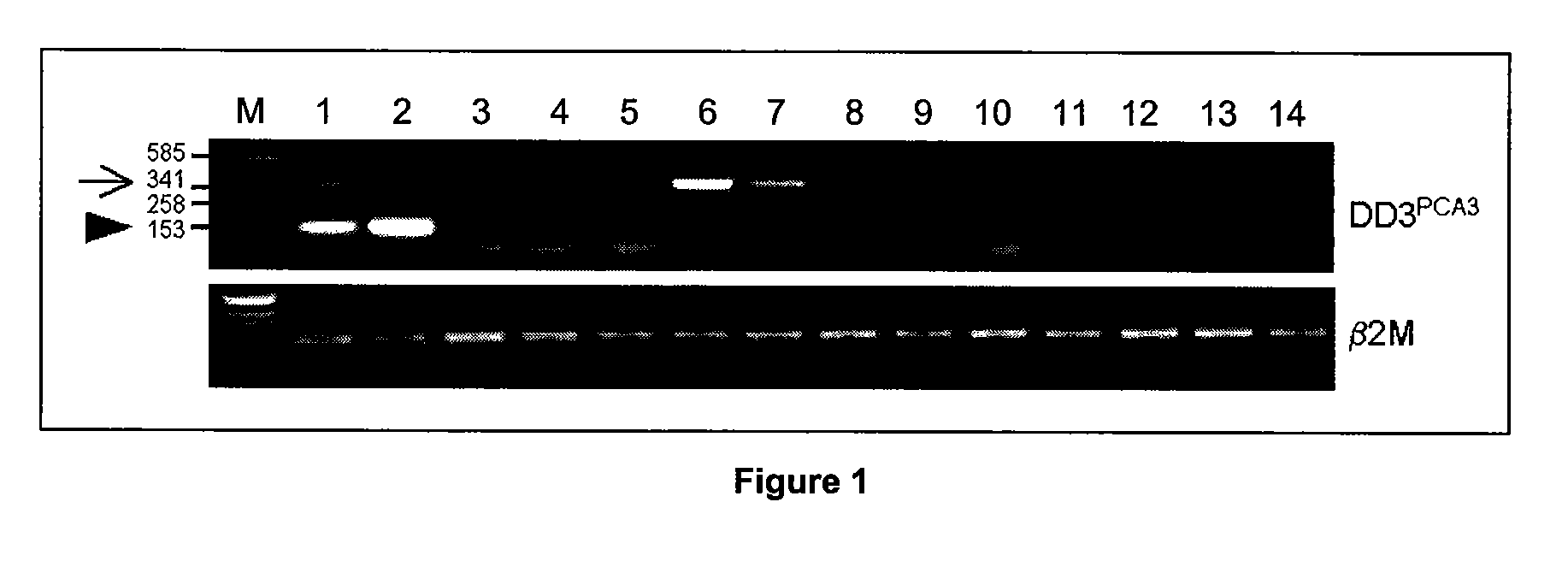Specific method of prostate cancer detection based on pca3 gene, and kits therefor
a prostate cancer and kit technology, applied in the field of prostate cancer, can solve the problems of only 79% of tpsa levels, psa leakage into the blood, and insufficient predictiveness of screening serum psa as an indicator of prostate cancer, so as to increase the specificity of the method and increase the detection sensitivity
- Summary
- Abstract
- Description
- Claims
- Application Information
AI Technical Summary
Benefits of technology
Problems solved by technology
Method used
Image
Examples
example 1
PCA3 is a Specific Marker for Prostate Cancer
[0091]Gandini et al., 2003 claim that the prostate-specific expression of PCA3 is restricted to exon 4 of the PCA3 gene. The authors show that RT-PCR amplification of the PCA3 transcript using primers specific for exons 1 and 3 also amplified a PCA3-specific product in several non-prostate tissues and cell lines. After the first description of the PCA3 gene, the exon 1 forward and exon 3 reverse PCR primers were used exactly as described in the letter by Gandini et al. supra. In the past four years, PCA3 was amplified in many samples using these primers, and non-prostatic expression of PCA3 has yet to be observed. Although it is not clear from the letter how many cycles of PCR amplification Gandini et al. supra performed, more than 35 rounds of amplification were never used for the results described in this example. It cannot be excluded that using more rounds of amplification might result in detection of low levels of expression. These l...
example 2
PCA3 Expression by RT-PCR
[0094]With respect to FIG. 3, transcription of the PCA3 gene or a PCA3-like gene is evident in tissues other than the prostate. However, these transcripts are either not spliced or are complementary (i.e. antisense) to the PCA3 gene. To date the observation of any alternatively spliced PCA3 variant (e.g. exon 1 to 3 product) in non-prostatic tissues has not occurred. For the application of PCA3 as a marker for prostate cancer this has one major implication: preferred primers for the amplification of the PCA3 transcripts in patient samples should, in one embodiment, cross the large (16 kb) first intron. This region of the PCA3 gene may be present in the alternative non-spliced or antisense transcripts, but is lacking from the prostate-specific spliced form of PCA3. Therefore, using exon 1 to exon 3 or 4 primer pairs, is one preferred means according to the present invention to detect amplified prostate-specific spliced form of PCA3 (especially in conditions w...
example 3
Assay to Detect Spliced PCA3 RNA Using Exon-Exon Junction Probes
[0095]This example illustrates some non-limiting embodiments of the assay for detecting PCA3 RNA in which sequences in the spliced RNA are amplified and detected by using a probe that specifically hybridizes to a chosen exon-exon junction of PCA3 that is in the amplified nucleic acid. Generally, one primer in the amplification reaction hybridizes specifically to a sequence in a first exon (or upstream exon) and the other primer used in the amplification reaction hybridizes specifically to a sequence in a second exon (or downstream exon), and the probe hybridizes to a sequence that spans the 3′ region of the first exon and the 5′ region of the second exon. That is, the probe is specific for a chosen exon-exon junction in an amplified sequence made from a spliced PCA3 RNA that lacks at least one intron between the upstream and downstream exon sequences to which the primers hybridize. Primers for use in amplifying sequence...
PUM
| Property | Measurement | Unit |
|---|---|---|
| temperature | aaaaa | aaaaa |
| pH | aaaaa | aaaaa |
| pH | aaaaa | aaaaa |
Abstract
Description
Claims
Application Information
 Login to View More
Login to View More - R&D
- Intellectual Property
- Life Sciences
- Materials
- Tech Scout
- Unparalleled Data Quality
- Higher Quality Content
- 60% Fewer Hallucinations
Browse by: Latest US Patents, China's latest patents, Technical Efficacy Thesaurus, Application Domain, Technology Topic, Popular Technical Reports.
© 2025 PatSnap. All rights reserved.Legal|Privacy policy|Modern Slavery Act Transparency Statement|Sitemap|About US| Contact US: help@patsnap.com



